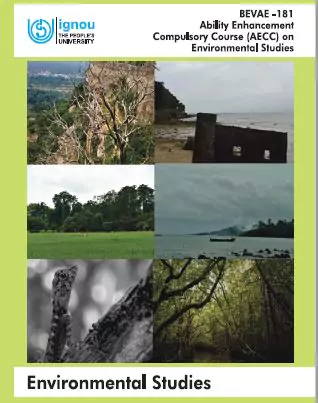‘Ignou Environmental Science For Students’ PDF Quick download link is given at the bottom of this article. You can see the PDF demo, size of the PDF, page numbers, and direct download Free PDF of ‘Environmental Science’ using the download button.
Ignou Complete Course On Environmental Science PDF Free Download

Types of Environment
Recall the definition of the environment, and consider a fish living in a natural pond which we have already discussed in the previous section. Its external environment will be the water in the pond which it primarily inhabits.
The water would contain nutrients, oxygen, and other organisms that the fish requires to sustain its life. As opposed to the external environment, the body cavity within the fish provides an internal environment quite separate from the outside environment.
The body surface acts as an exchange barrier between the internal and the external environment of the fish.
The internal environment is relatively stable as compared to the external environment. However, illness and injury or even environmental stress can upset it.
But when the cause of the disturbance is removed, the internal environment comes back to its original condition. The pond which the fish inhabits is its natural environment.
The abiotic factors of the pond, like light, temperature, depth, nutrients, and dissolved gases will provide the life-supporting chemical and physical factors for the fish.
The other living organisms inhabiting the pond, like bacteria, insects, worms, mollusks, tadpoles, frogs, and aquatic vegetation could be food for the fish.
Examples of such natural environments on land include forests, grasslands, savannahs, and deserts.
So far we have discussed only the natural environment but several components of the environment are created by humans, like crop fields, cities, and industrial spaces.
These are places made artificially by humans through planned manipulation.
Significance of the Environment for Life
Whatever type of environment organisms inhabit, they all need life-supporting elements for their survival. These include air that they breathe, food and water they take in, and shelter either as natural (like caves and tree holes) or as artificial dwellings (like houses).
The environment is the only source that provides these life-supporting elements. We make use of the land for cultivating crops. Soil provides nutrients needed for the growth of plants.
The landform determines the soil types found in any one area and soil itself varies from place to place. Some soils are rich in nutrients and others are lacking in them.
The soils lacking nutrients need the addition of fertilizers. Climate and short-term weather changes are characterized mainly by wind, temperature, pressure, and rainfall and are
determined by the properties of the atmosphere.
Air in the atmosphere provides living organisms with oxygen, without which survival of the most of the living organisms will be threatened.
Human-Environment Relationship
As we know from the previous section all living beings are dependent upon their immediate surroundings for their sustenance and survival.
There are two distinct situations observed if we trace the history of human civilization.
The first situation is that human beings adjust or adapt to the prevailing environmental conditions.
Those who could not adapt or adjust perished. Similar situations can be observed among plants and animals.
As human civilization progressed, people developed knowledge, skills, and technology to subjugate nature.
This happened faster after the Renaissance and Industrial Revolution. It has improved the standard of living as well as made human life comfortable.
However, this has led to irreparable damage to the environment and a threat to human society as well as the survival of the planet Earth.
| Author | – |
| Language | English |
| No. of Pages | 63 |
| PDF Size | 14 MB |
| Category | Plant And Environment |
| Source/Credits | egyankosh.ac.in/ |
Related PDFs
Plant Breeding Principles And Methods PDF By BD Singh
Ignou Environmental Science PDF Free Download
